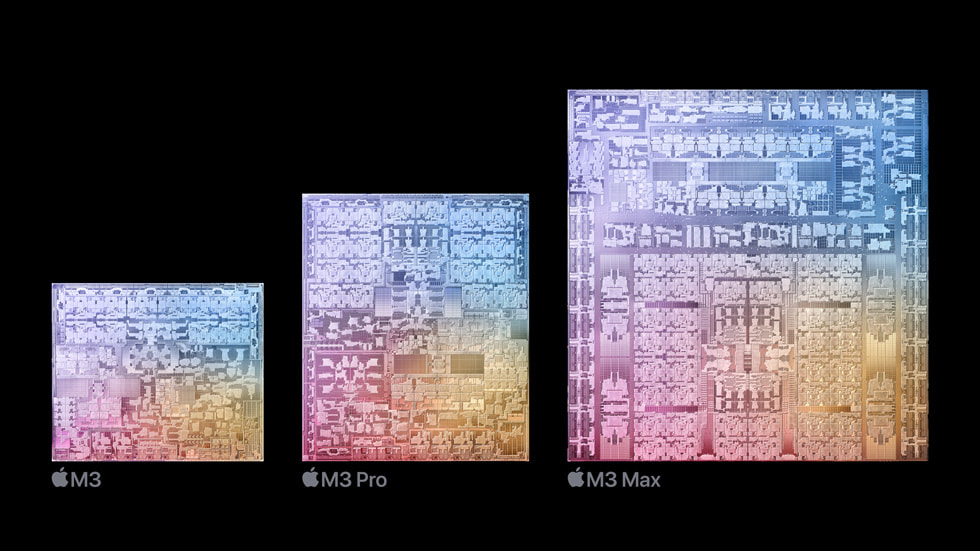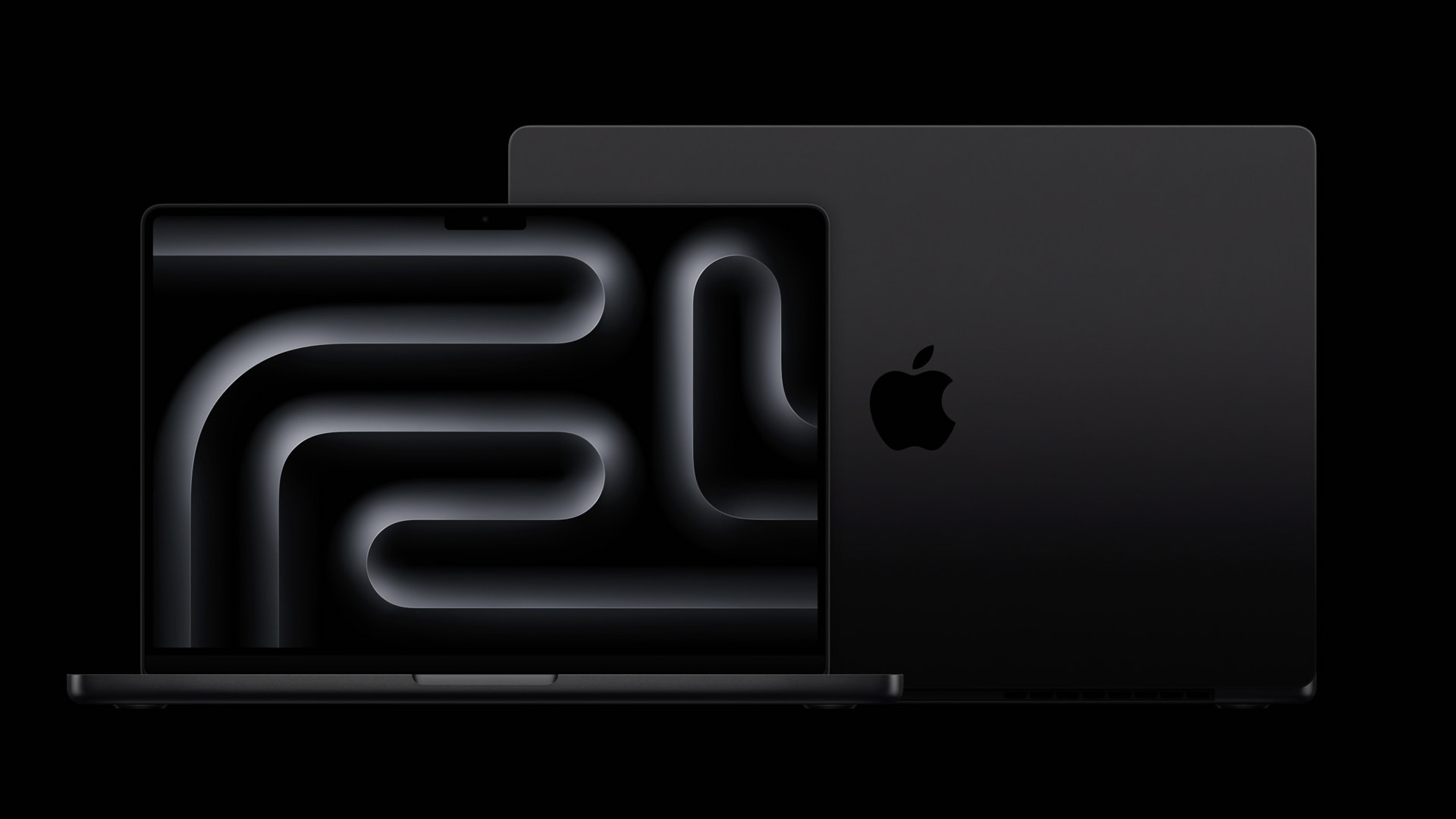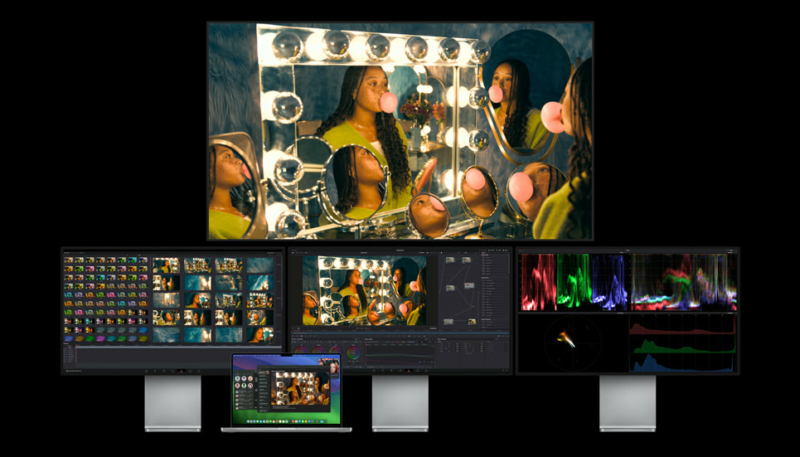Apple held a short but interesting media event tonight, where it unveiled its new MacBook Pro and iMac models, all powered by the company’s new M3 lineup of chips.
M3, M3 Pro, and M3 Max Chips
Apple tonight unveiled its new M3, M3 Pro, and M3 Max chips, which feature dramatically increased performance and new capabilities for the company’s Mac lineup. The new chips are the first built using TSMC’s 3-nanometer process technology. The new process allows packing more transistors into a smaller area, resulting in improved performance and efficiency.
In addition to being faster, the M3 family of chips boasts a new technology called Dynamic Caching, bringing new features like mesh shading and hardware-accelerated ray tracing to the Mac for the first time. This results in rendering speeds that are up to 2.5x faster than the M1 family of processors. The M3 performance and efficiency cores are 30& and 50& faster than they were in the M1, respectively. Meanwhile, the M3 Neural Engine offers a 60% increase in performance over the M1 family’s Neural Engine.
The M3 chip also includes new media engine support for AV1 decode, which Apple says will result in a more efficient and high-quality video streaming experience.
“Apple silicon has completely redefined the Mac experience. Every aspect of its architecture is designed for performance and power efficiency,” said Johny Srouji, Apple’s senior vice president of Hardware Technologies. “With 3-nanometer technology, a next-generation GPU architecture, a higher-performance CPU, faster Neural Engine, and support for even more unified memory, M3, M3 Pro, and M3 Max are the most advanced chips ever built for a personal computer.”
The next-generation GPU inside the M3 family of chips features Dynamic Caching that provides an advantage over traditional GPUs, as it allocates Mac local memory in hardware in real time, using only the exact amount of memory needed for each task. This dramatically increases the average utilization of the GPU, significantly improving performance for demanding pro apps and games.
The next-generation M3, M3 Pro, and M3 Max CPU boasts performance cores of up to 30% faster than the M1 family, so developers will see faster compiling of code in Xcode. The efficiency cores are up to 50% faster than the same cores in the M1, meaning both performance and battery life are much improved.

M3
The M3 features 25 billion transistors, a 5 billion increase over the M2. Its 10-core GPU is 65 percent faster than M1 for graphics performance. It boasts an 8-core CPU, with four performance cores and four efficiency cores, for CPU performance that is up to 35% faster than M1. The chip supports up to 24GB of unified memory.
M3 Pro
The M3 Pro boasts 37 billion transistors and an 18-core GPU, the GPU is up to 40% faster than M1 Pro. Support for unified memory is up to 36GB, while the 12-core CPU design has six performance cores and six efficiency cores, for single-threaded performance that is up to 30% faster than M1 Pro.
M3 Max
The M3 Max sports up to 92 billion transistors, boasting a 40-core GPU that is up to 50% faster than the M1 Max and offers support for up to 128GB of unified memory. A 16-core CPU features 12 performance cores and four efficiency cores, providing performance that’s up to 80% faster than M1 Max. The M3 Max also has two ProRes engines.
24-inch iMac With M3
Apple also debuted an updated 24-inch iMac, powered by the M3 chip. making the world’s best all-in-one even more powerful and more capable. iMac with M3 is up to 2x faster than the prior generation with M1, and is up to 2.5x faster than the most popular Intel-powered 27-inch models, and 4x faster than the most powerful 21.5-inch model.

The new iMac also features a 4.5K Retina display with 11.3 million pixels and over a billion colors, faster wireless connectivity, and a seamless experience with the iPhone.
The iMac retains its thin design and will be available in seven colors.
When compared to the previous-generation 24-inch iMac, Safari and Microsoft Excel both perform up to 30% faster, while gamers will appreciate faster loading and up to 50% faster frame rates.
M3-Powered MacBook Pro Lineup
Apple also unveiled a new MacBook Pro lineup, powered by Apple’s all-new M3 family of chips, the M3, M3 Pro, and M3 Max.
The new 14‑inch MacBook Pro with M3 now starts at $1,599. The 14- and 16‑inch MacBook Pro with M3 Pro offers support for up to 128GB of unified memory. The MacBook Pro with M3 Max enables extreme workflows and multitasking across pro apps.
Both the M3 Pro and M3 Max models are now available in a beautiful space black aluminum finish.

All of the new MacBook Pro models feature a Liquid Retina XDR display with 20% brighter SDR content, a built-in 1080p camera, a six-speaker sound system, and a wide array of connectivity options.
The lineup offers up to 22 hours of battery life while delivering the same level of performance whether it is plugged in or is running on its battery.
14-inch MacBook Pro with M3
The 14‑inch MacBook Pro with M3 is up to 60 faster than the 13‑inch MacBook Pro with M1, and its advanced thermal system, allows users to access the full potential of M3.
14- and 16-inch MacBook Pro with M3 Pro
The 14-inch and 16-inch MacBook Pro with M3 Pro provides even greater performance, supports more unified memory, and is up to 40% faster than the 16‑inch MacBook Pro with M1 Pro.
14-inch and 16-inch MacBook Pro with M3 Max
MacBook Pro with M3 Max should appeal to users with extreme workflows like machine learning programmers, 3D artists, and video editors. The M3 Max-powered MacBook Pros are up to 2.5x faster than the 16-inch MacBook Pro with M1 Max, and up to 11x faster than the fastest Intel-based MacBook Pro model. The new laptops support up to 128GB of unified memory.
Pricing and Availability
- Customers can order the new MacBook Pro starting today, Monday, October 30, on the Online Apple Store and in the Apple Store app in 27 countries and regions, including the U.S. It will begin arriving to customers, and will be in Apple Store locations and Apple Authorized Resellers, starting Tuesday, November 7.
- The 14-inch MacBook Pro with M3 starts at $1,599 (U.S.) and $1,499 (U.S.) for education; the 14‑inch MacBook Pro with M3 Pro starts at $1,999 (U.S.) and $1,849 (U.S.) for education; and the 16‑inch MacBook Pro starts at $2,499 (U.S.) and $2,299 (U.S.) for education.
- The new 24-inch iMac with M3 is available to order today, Monday, October 30, on apple.com/store and in the Apple Store app in 27 countries and regions, including the U.S. It will begin arriving to customers and will be in Apple Store locations and Apple Authorized Resellers starting Tuesday, November 7.
- iMac with 8-core GPU starts at $1,299 (U.S.) and $1,249 (U.S.) for education, and is available in green, pink, blue, and silver. It features an 8-core CPU, 8GB of unified memory, 256GB SSD, two Thunderbolt ports, Magic Keyboard, and Magic Mouse.
- iMac with 10-core GPU starts at $1,499 (U.S.) and $1,399 (U.S.) for education, and is available in green, yellow, orange, pink, purple, blue, and silver. It features an 8-core CPU, 8GB of unified memory, 256GB SSD, two Thunderbolt ports, two additional USB 3 ports, Magic Keyboard with Touch ID, Magic Mouse, and Gigabit Ethernet.


